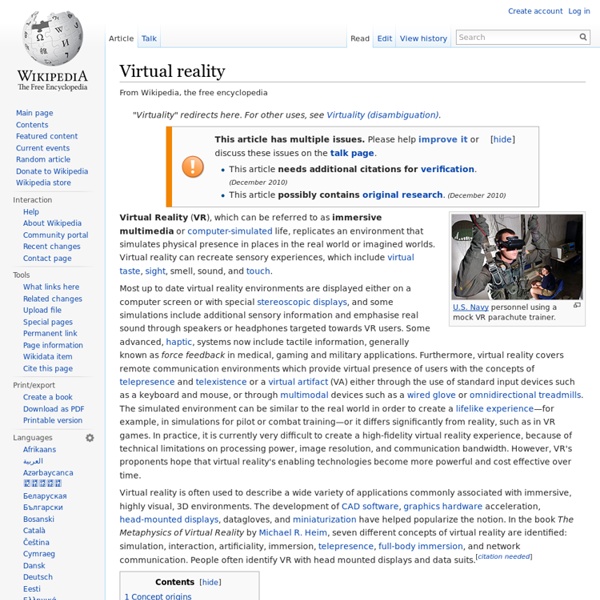Virtual environment software
Virtual environment software refers to any software, program or system that implements, manages and controls multiple virtual environment instances. The software is installed within an organization's existing IT infrastructure and controlled from within the organization itself. From a central interface the software creates an interactive and immersive experience for administrators and users. Uses[edit] Virtual environment software can be purposed for any use.
Virtual environment
This article or section is incomplete and its contents need further attention. Some sections may be missing, some information may be wrong, spelling and grammar may have to be improved etc. Use your judgment! 1 Definition This is a short overview entry with pointers to more specialized articles in this wiki. It also includes some general links and reference.
History of Virtual Reality - where did it all begin?
The History of Virtual Reality – otherwise known as VR. A term that applies to simulations made by technology in an environment that mimics the real world. Also as imaginary worlds. Most VR programs try to create a visual experience for its audience – a form of immersive entertainment.
VIRTUAL REALITY - History
Expo/Theater/Virtual Environments | Forward | Back | Map | Information | Expo Home | Beginnings
Mural
A mural is any piece of artwork painted or applied directly on a wall, ceiling or other large permanent surface. A distinguishing characteristic of mural painting is that the architectural elements of the given space are harmoniously incorporated into the picture. Some wall paintings are painted on large canvases, which are then attached to the wall (e.g., with marouflage).
Virtual Environments in Clinical Psychology and Neuroscience - A book about the applications of virtual reality in medicine, neurology and psychology
Scientific discovery is a form of problem solving, and… the processes whereby science is carried on can be explained in the terms that have been used to explain the processes of problem solving. Simon, 1966 We are entering the second wave of virtual reality (VR) applications in medicine. Surgical simulations and training, three-dimensional anatomy, and the new field of real-time three- dimensional physiological imaging are some of the more notable uses and applications of VR in the first wave in clinical medicine.
Jacqui Taylor's Thesis Research Survey (1): Phobias
Thank you for taking the time to complete this survey and assist me with my thesis research. This survey should only take about 10-20 minutes of your time to complete. All questions marked with asterisks (*) require an answer in order to progress through the survey.
Kalkmalerier-Church Murals in Danish Churches- 360 Panorama - panorama foto
The Danish and Swedish church paintings are a unique concentration of church frescoes and murals in the world. More than 600 churches have murals dated back to the Middle Ages. In most of Europe mediveal frescoes were destroid during the reformation but in Denmark most of them were covered by limewash and discovered again in the 1860s up until today. You can still discover hidden paintings under the many layers of limewash. There are 2 types of murals, the old Romanesque style made by artists coming from the rest of Europe dating back to the 12th century, and the Gothic style made from the middle of 13th century to 15th century. The paintings from the 13-15th century are made by local Danish artists who developed there own style.
Virtual Reality and Education Virtual Reality
Education is another area which has adopted virtual reality for teaching and learning situations. The advantage of this is that it enables large groups of students to interact with each other as well as within a three dimensional environment. It is able to present complex data in an accessible way to students which is both fun and easy to learn. Plus these students can interact with the objects in that environment in order to discover more about them. Virtual reality astronomy



